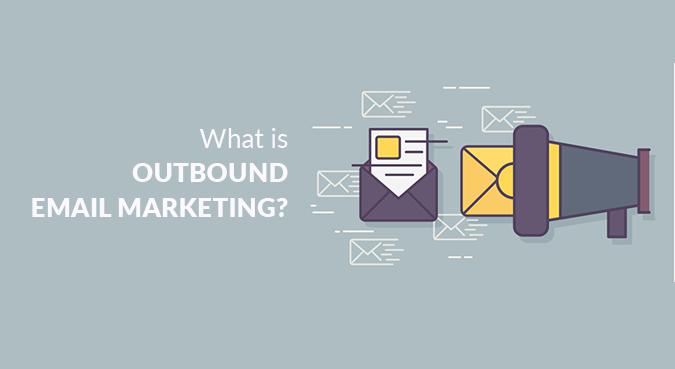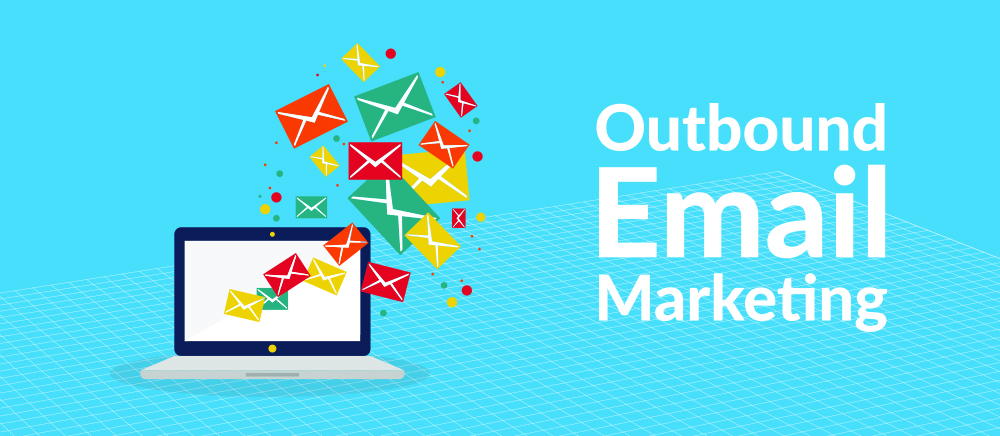
Maybe you are a start-up company and you have yet to hire a complete team of people to focus on different areas for your business. Maybe you and your business partner/s are still doing everything by yourselves. Don’t worry, we get you. We’ve been there and we know how hard it is to be juggling three or more responsibilities in order to grow your company.
For your company to grow, you need customers. And let’s face it, every start-up company’s struggle is to become known to people who may already be receiving the service you offer from someone else a.k.a. your competition. So, how do introduce your brand?
Have you ever opened your email to find that you received a message from a company or person you’ve never heard of before, offering you a product or service? That is an example of outbound email marketing done by a company in an attempt to make you want to do business with them.

Outbound means that you are the one sending the message, making the call or reaching out to another individual. In marketing, this is usually how potential customers hear about you and from you for the first time. It may also be the last time if the first email you send is not engaging.
Question: But what is the difference between Inbound and Outbound Email Marketing?
Inbound Email Marketing is when you send emails (such as promotional emails, updates, announcements, newsletters and the like) to people who signed up to receive them. These are people who may already be your customers, people who may have expressed interest in your product or service before or are just looking to receive information regarding your service/product. These prospects may have given their contact information to you through lead capture forms in your website or as part of a purchase or subscription to your service. An example of this is when you look for eBooks about a topic you’re interested in and in order to obtain this eBook that you found, you must fill out a lead capture form with your first name and email address. After which, you will receive the link to download the eBook in your email.
Outbound Email Marketing is reaching out directly to people who have never heard of your company before and did not subscribe to receiving notifications and offers from you. Usually, the lists of addresses that receive these emails are purchased or have been generated by the company that sends the emails.
Now, there is no such thing as a perfect marketing strategy. There are advantages as well as disadvantages in outbound email marketing. But with every problem, there is a solution. Below are lists of the pros and cons of email marketing (and some solutions!).
Advantages of Email Marketing
- Personal touch – You can personalize the emails you send and make sure they are relevant to the people who receive them by segmenting your contact lists. When people feel that the message they are reading is written for them, they are more likely to engage with your emails than to emails that have obviously been sent to many others.
- Time-Saving – With automated email responses, you can get in touch with your customers as soon as they input their email address in a lead capture form. For example, a welcome email when they subscribe to your newsletter or asking them to confirm their email address. It is also time-saving in the sense that you can create a marketing email in just hours, or minutes even, and send it to thousands of people in less time.
- Easier Keeping Track – Open tracking helps you monitor your emails to see which ones were received, opened, and allows you to see which email addresses are no longer active or have unsubscribed to your emails. This way, you can remove inactive contacts so it does not affect your deliverability rates and open rates.
- Cost Savings – It does not require as many hours of production time as in print ads and cold calling potential customers. It also does not require as much manpower which means fewer people to pay with more potential customers to reach with the message.
- Convenient for the Reader – Unlike receiving cold calls, receiving cold emails is more convenient for the customer because they can open the message whenever they like and can reread it should they wish to check what they may have missed.
Now that we know the advantages of outbound email marketing, let’s look at the reasons it may not have worked for other businesses and the solutions we found for you to overcome these challenges.
Disadvantages of Email Marketing and How to Solve Them
- Format Incompatibility – Because of the different settings on computers and mobile devices, some emails may look very different on a phone from the desktop view. 75% of Gmail users access their emails on mobile devices, and if your email format is not mobile-friendly, it won’t look appealing or even seem annoying to the reader who won’t even bother reading it. An affordable email template editor that offers designs that is compatible with phones and tablets is TemplateTed.com. (The good thing with this editing tool is that it is currently in beta and users can still register for free.)
- Spam – Perhaps one of the biggest problems for outbound marketing campaigns is getting your emails marked as spam. You wouldn’t want your well-crafted, compelling emails that could potentially earn you new customers to go straight to junk, right? When your emails are sent straight to the spam box, this gives you low deliverability which could get you blocked by email service providers. To avoid this, make your subject lines eye-catching without having to use “spam words” such as buy, sale, save $, make $, free, cheap, etc. These words may get your emails filtered into the spam box even though they would have worked well in a headline or call-to-action.
- Email Skimming – A lot of people no longer read the entire body of text. Instead, they scan for keywords that may be relevant to what they’re interested in and if most of the words used are hard for them to relate to, they won’t bother reading it to the end. It is ideal to send concise emails that go straight to what you want to say to the readers because a huge block of text is not always appealing to a reader.
- Low Open Rates – This could be a result of you sending emails way too often making people feel they are bombarded with messages they don’t need to read. This could drive them to become inactive or unsubscribe from your emails altogether. The same with spam, try to use enticing subject lines without having to use spam words too often. Personalized subject lines have also been observed as 20% more likely to get opened, and so are short, straight-to-the-point subject lines (30 characters or less).
- Reputation – It is more common in outbound email marketing than in inbound that receiving emails may be unappealing just because they did not ask to receive them. Unsolicited emails may leave a bad taste in the receiver’s mouth especially if the unsubscribe button is either difficult to find or nowhere to be found within the email. This may make them feel they are forced to receive similar emails from your company that they have no option to opt-out of, therefore giving you a bad reputation. Does Outbound Email Marketing really work?
Of course, we wouldn’t bother bringing you here if we can’t prove to you that outbound email marketing works and how it could be a great strategy in growing your customer base.
One of the biggest factors that contribute to outbound email marketing success is that it’s one of the easiest ways to reach mobile customers. According to a study done by Pew Research Center, 52% of US cellphone owners access their emails from their phones, and you guessed it, email marketing works great with mobile devices. Additionally, Forrester Research released a study that found 42% of email messages were opened by consumers on their smartphones and 17% were opened on tablets. This means that nearly three out of every five email marketing messages doubles as a mobile marketing message. That’s a huge piece of the pie you don’t want to miss out on.
So, how do I start?
Now that you know how it works, the pros and cons, and overcoming the disadvantages, the only question left is this: How in the world do I begin? Well, you’re in luck!
We have created an in-depth marketing guide on how to successfully run an outbound email marketing campaign which you can check out here, but here are the essentials you need in order to take that first step:
1. Get an Emailing List – Your emailing list is the most crucial part of your OEM campaign. There are several ways to do this either to purchase one from a reputable provider or manually generate one yourself. Each has its own pros and cons and it’s up to you as a marketer to weigh the scales and decide what option best suits your objectives.
2. Segment your list– One very common mistake a lot of marketing does is when running OEM campaigns is “bulk and blast” (create a generic message to the entire list and fire away). This will never work. Make sure you segment your list based on audience type and create a direct one-to-one personalized message that targets your audience’s pain points.
3. Choose the best emailing software – You have your list and have segmented it, the next step is to choose what platform to execute your campaign on. This goes hand in hand with your list as a good emailing software will allow you to run your emailing list through a variety of health and anti-spam checks that prevent you from becoming blacklisted. Without scrubbing your email list first, you run the risk of damaging your sender score which can negatively affect your email deliverability.(MailClickConvert strips out duplicates, spam traps, and hard bounces upon import. This process allows your IP’s to remain clean and prevents you from being blacklisted).
4. Keep your email concise and use catchy subject lines – Your prospects receive tons of emails on a daily basis so your competition for them to open your email is really tight. Make sure you create catchy subject lines that pique your prospect's interest and keep your email concise, smart, and provides value. These are the main steps you need to take in order for you to run an outbound email marketing campaign and be successful in it. For a more in-depth discussion and tips on email marketing, check out our eBook here!
Wrapping up!
Now that you understand the basics, it’s important to think about the benefits you can provide to your prospective clients. Companies do not have time to read an e-mail that is too long. Additionally, It’s important to remember that although the technical aspects of outbound email marketing can be given some of the credit for a campaign’s effectiveness, it is the ability to write persuasive and compelling emails that is critical to success. Keep sharpening those copywriting skills, and good luck using outbound email marketing as another powerful marketing strategy in 2018.
- Log in to post comments

